HR Roles: Transactional, Transformational, and Strategic Report
VerifiedAdded on 2020/03/16
|7
|1213
|70
Report
AI Summary
This report examines the multifaceted roles of Human Resources (HR) within an organization, differentiating between transactional and transformational HR functions. It explores the day-to-day operational aspects of transactional HR, such as recruitment, payroll, and employee monitoring, contrasting them with the strategic, forward-thinking nature of transformational HR, which focuses on aligning HR goals with organizational objectives and proactive issue management. The report further highlights the contributions of strategic HR, including aligning workforce goals, recruiting top talent, employee retention strategies, and increasing transactional efficiency. The author reflects on their acquired knowledge, emphasizing the shift from a basic understanding of HR to recognizing its strategic importance in talent acquisition, employee satisfaction, and organizational goal alignment. The report concludes by outlining essential HR management skills, such as organizational, negotiation, communication, change management, and conflict resolution skills, crucial for effective HR practice. Finally, the report provides a list of references used in the research.
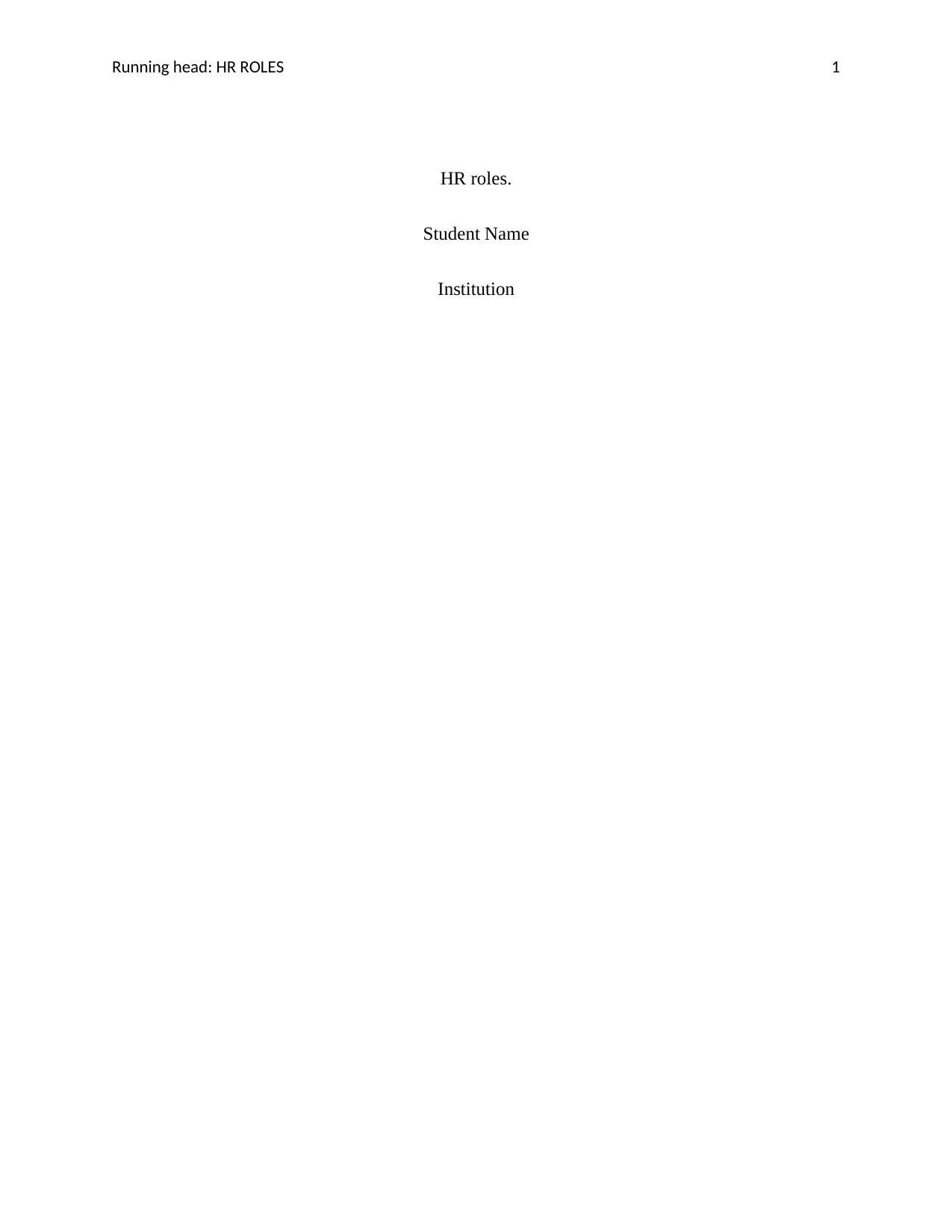
Running head: HR ROLES 1
HR roles.
Student Name
Institution
HR roles.
Student Name
Institution
Paraphrase This Document
Need a fresh take? Get an instant paraphrase of this document with our AI Paraphraser
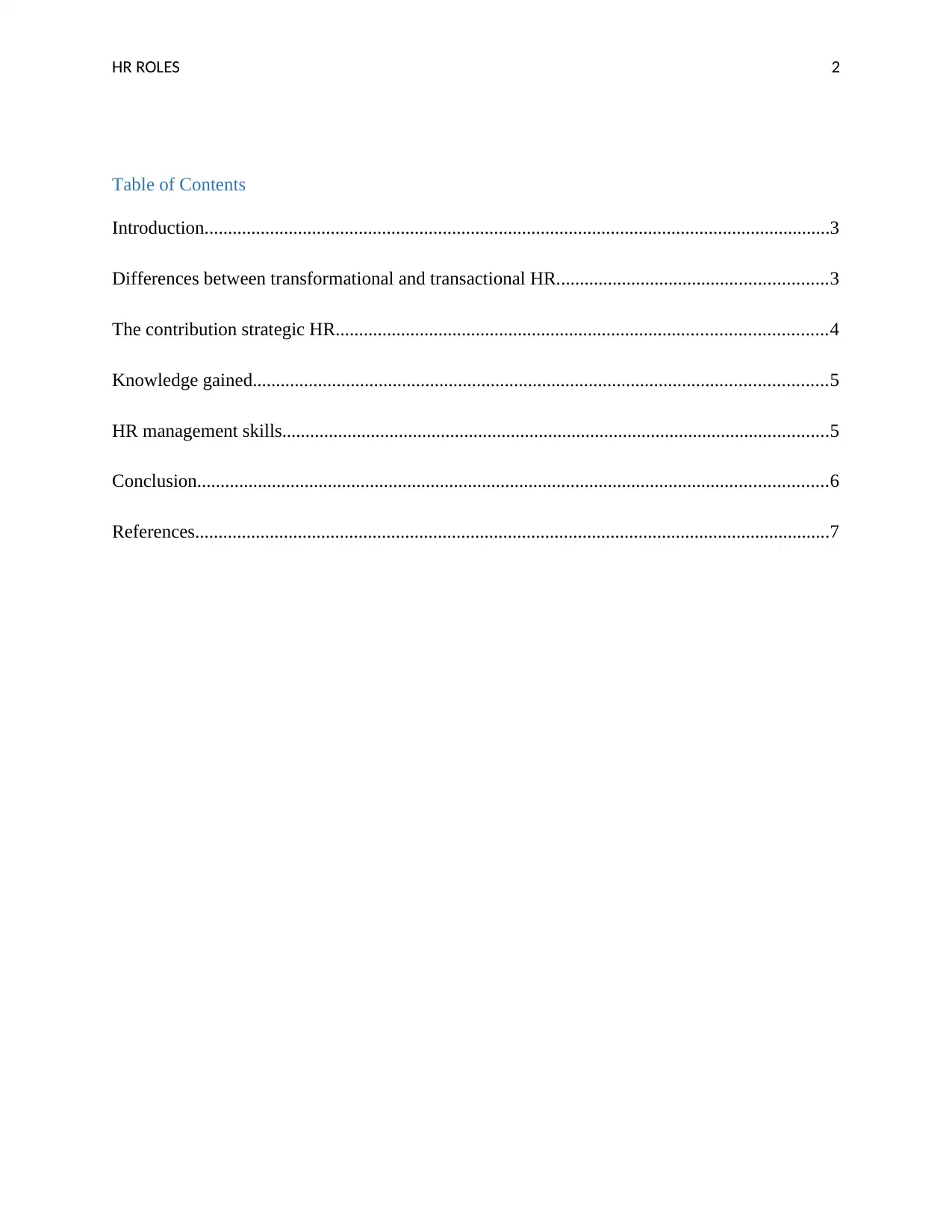
HR ROLES 2
Table of Contents
Introduction......................................................................................................................................3
Differences between transformational and transactional HR..........................................................3
The contribution strategic HR.........................................................................................................4
Knowledge gained...........................................................................................................................5
HR management skills.....................................................................................................................5
Conclusion.......................................................................................................................................6
References........................................................................................................................................7
Table of Contents
Introduction......................................................................................................................................3
Differences between transformational and transactional HR..........................................................3
The contribution strategic HR.........................................................................................................4
Knowledge gained...........................................................................................................................5
HR management skills.....................................................................................................................5
Conclusion.......................................................................................................................................6
References........................................................................................................................................7
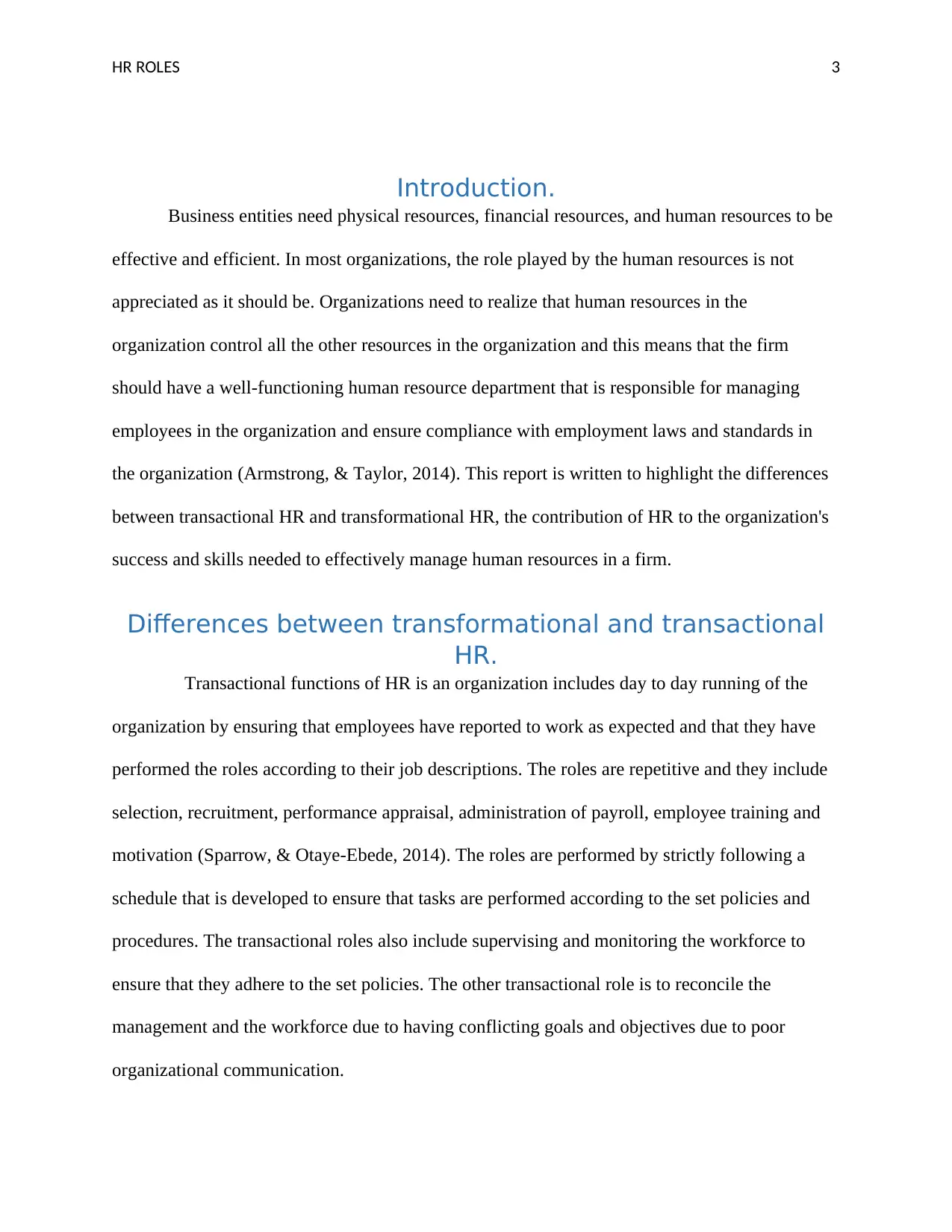
HR ROLES 3
Introduction.
Business entities need physical resources, financial resources, and human resources to be
effective and efficient. In most organizations, the role played by the human resources is not
appreciated as it should be. Organizations need to realize that human resources in the
organization control all the other resources in the organization and this means that the firm
should have a well-functioning human resource department that is responsible for managing
employees in the organization and ensure compliance with employment laws and standards in
the organization (Armstrong, & Taylor, 2014). This report is written to highlight the differences
between transactional HR and transformational HR, the contribution of HR to the organization's
success and skills needed to effectively manage human resources in a firm.
Differences between transformational and transactional
HR.
Transactional functions of HR is an organization includes day to day running of the
organization by ensuring that employees have reported to work as expected and that they have
performed the roles according to their job descriptions. The roles are repetitive and they include
selection, recruitment, performance appraisal, administration of payroll, employee training and
motivation (Sparrow, & Otaye-Ebede, 2014). The roles are performed by strictly following a
schedule that is developed to ensure that tasks are performed according to the set policies and
procedures. The transactional roles also include supervising and monitoring the workforce to
ensure that they adhere to the set policies. The other transactional role is to reconcile the
management and the workforce due to having conflicting goals and objectives due to poor
organizational communication.
Introduction.
Business entities need physical resources, financial resources, and human resources to be
effective and efficient. In most organizations, the role played by the human resources is not
appreciated as it should be. Organizations need to realize that human resources in the
organization control all the other resources in the organization and this means that the firm
should have a well-functioning human resource department that is responsible for managing
employees in the organization and ensure compliance with employment laws and standards in
the organization (Armstrong, & Taylor, 2014). This report is written to highlight the differences
between transactional HR and transformational HR, the contribution of HR to the organization's
success and skills needed to effectively manage human resources in a firm.
Differences between transformational and transactional
HR.
Transactional functions of HR is an organization includes day to day running of the
organization by ensuring that employees have reported to work as expected and that they have
performed the roles according to their job descriptions. The roles are repetitive and they include
selection, recruitment, performance appraisal, administration of payroll, employee training and
motivation (Sparrow, & Otaye-Ebede, 2014). The roles are performed by strictly following a
schedule that is developed to ensure that tasks are performed according to the set policies and
procedures. The transactional roles also include supervising and monitoring the workforce to
ensure that they adhere to the set policies. The other transactional role is to reconcile the
management and the workforce due to having conflicting goals and objectives due to poor
organizational communication.
⊘ This is a preview!⊘
Do you want full access?
Subscribe today to unlock all pages.

Trusted by 1+ million students worldwide
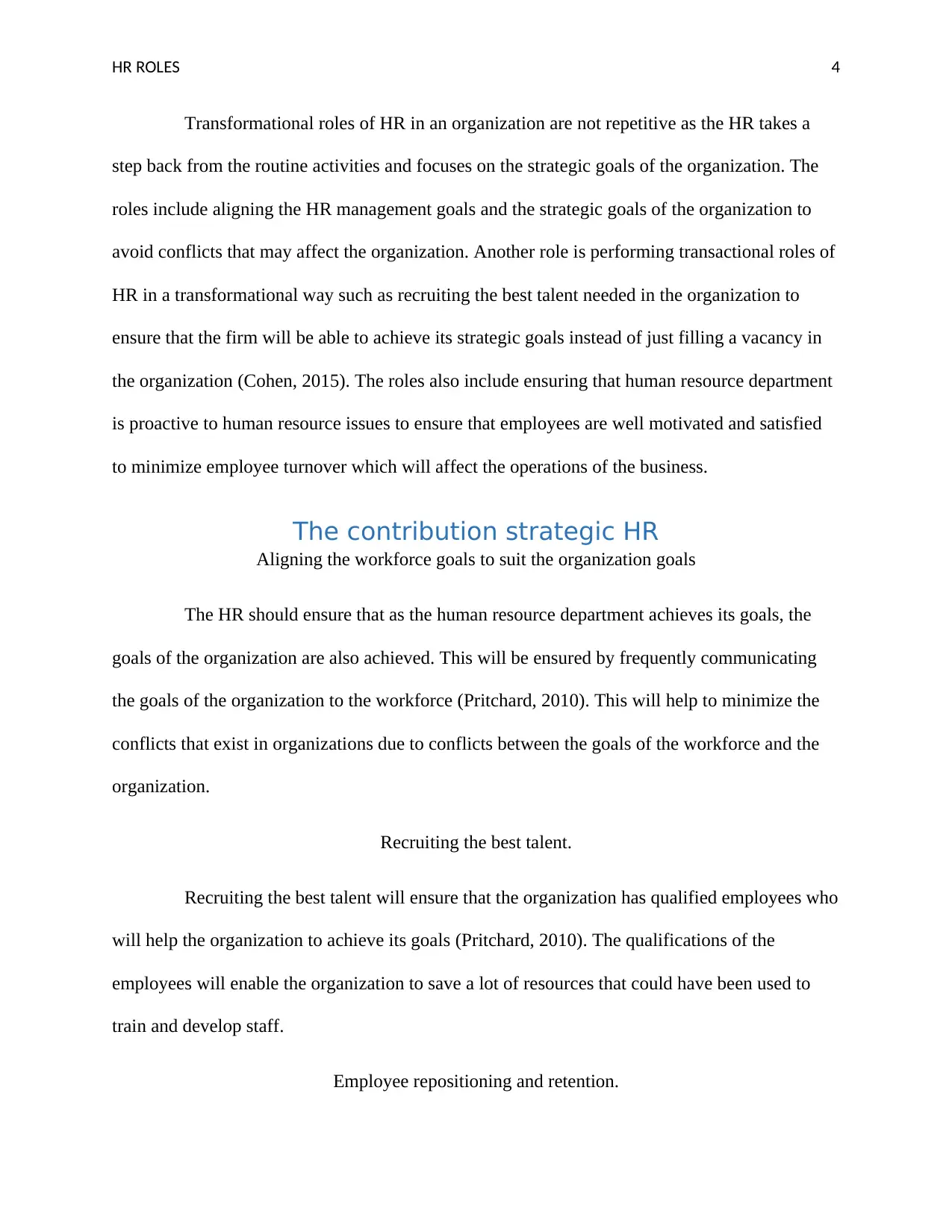
HR ROLES 4
Transformational roles of HR in an organization are not repetitive as the HR takes a
step back from the routine activities and focuses on the strategic goals of the organization. The
roles include aligning the HR management goals and the strategic goals of the organization to
avoid conflicts that may affect the organization. Another role is performing transactional roles of
HR in a transformational way such as recruiting the best talent needed in the organization to
ensure that the firm will be able to achieve its strategic goals instead of just filling a vacancy in
the organization (Cohen, 2015). The roles also include ensuring that human resource department
is proactive to human resource issues to ensure that employees are well motivated and satisfied
to minimize employee turnover which will affect the operations of the business.
The contribution strategic HR
Aligning the workforce goals to suit the organization goals
The HR should ensure that as the human resource department achieves its goals, the
goals of the organization are also achieved. This will be ensured by frequently communicating
the goals of the organization to the workforce (Pritchard, 2010). This will help to minimize the
conflicts that exist in organizations due to conflicts between the goals of the workforce and the
organization.
Recruiting the best talent.
Recruiting the best talent will ensure that the organization has qualified employees who
will help the organization to achieve its goals (Pritchard, 2010). The qualifications of the
employees will enable the organization to save a lot of resources that could have been used to
train and develop staff.
Employee repositioning and retention.
Transformational roles of HR in an organization are not repetitive as the HR takes a
step back from the routine activities and focuses on the strategic goals of the organization. The
roles include aligning the HR management goals and the strategic goals of the organization to
avoid conflicts that may affect the organization. Another role is performing transactional roles of
HR in a transformational way such as recruiting the best talent needed in the organization to
ensure that the firm will be able to achieve its strategic goals instead of just filling a vacancy in
the organization (Cohen, 2015). The roles also include ensuring that human resource department
is proactive to human resource issues to ensure that employees are well motivated and satisfied
to minimize employee turnover which will affect the operations of the business.
The contribution strategic HR
Aligning the workforce goals to suit the organization goals
The HR should ensure that as the human resource department achieves its goals, the
goals of the organization are also achieved. This will be ensured by frequently communicating
the goals of the organization to the workforce (Pritchard, 2010). This will help to minimize the
conflicts that exist in organizations due to conflicts between the goals of the workforce and the
organization.
Recruiting the best talent.
Recruiting the best talent will ensure that the organization has qualified employees who
will help the organization to achieve its goals (Pritchard, 2010). The qualifications of the
employees will enable the organization to save a lot of resources that could have been used to
train and develop staff.
Employee repositioning and retention.
Paraphrase This Document
Need a fresh take? Get an instant paraphrase of this document with our AI Paraphraser
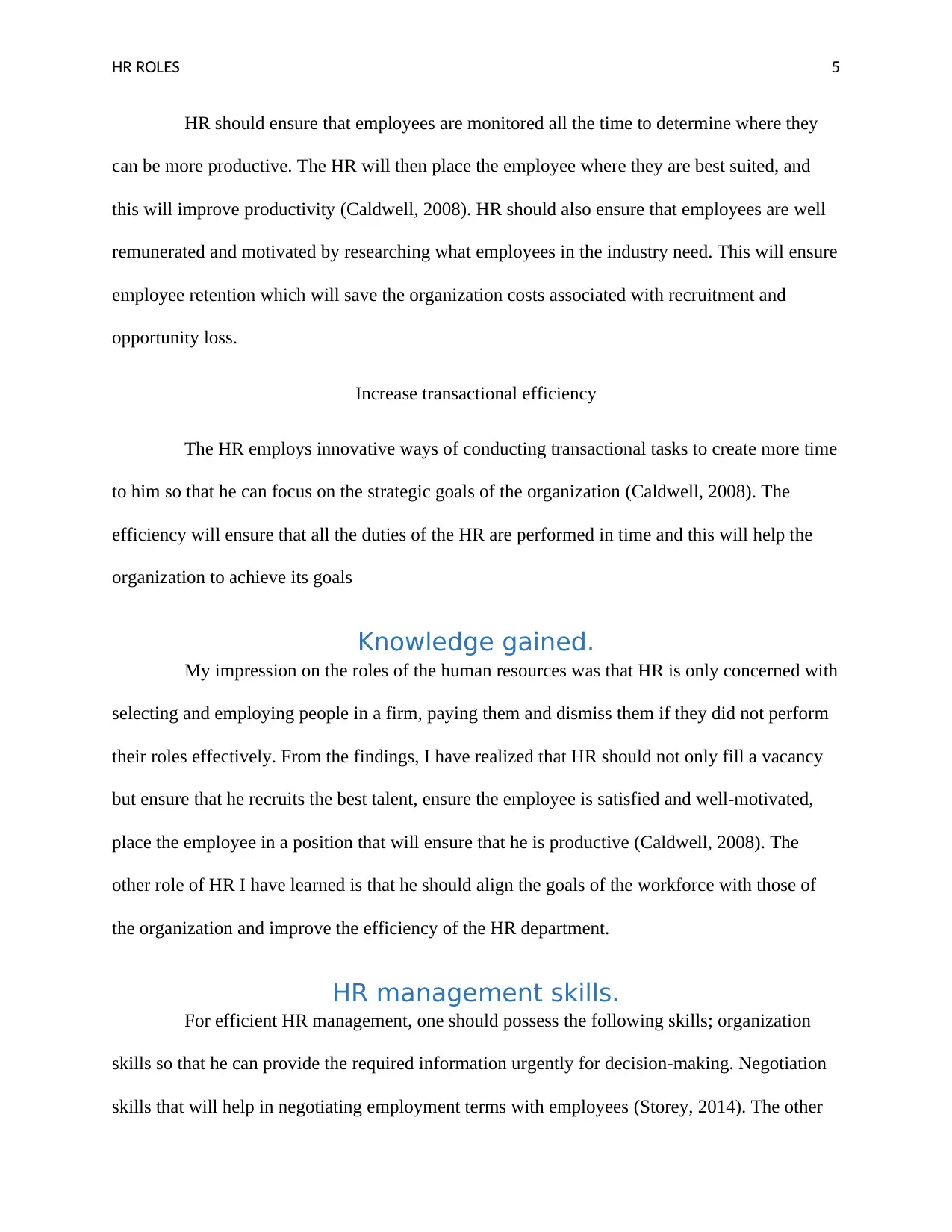
HR ROLES 5
HR should ensure that employees are monitored all the time to determine where they
can be more productive. The HR will then place the employee where they are best suited, and
this will improve productivity (Caldwell, 2008). HR should also ensure that employees are well
remunerated and motivated by researching what employees in the industry need. This will ensure
employee retention which will save the organization costs associated with recruitment and
opportunity loss.
Increase transactional efficiency
The HR employs innovative ways of conducting transactional tasks to create more time
to him so that he can focus on the strategic goals of the organization (Caldwell, 2008). The
efficiency will ensure that all the duties of the HR are performed in time and this will help the
organization to achieve its goals
Knowledge gained.
My impression on the roles of the human resources was that HR is only concerned with
selecting and employing people in a firm, paying them and dismiss them if they did not perform
their roles effectively. From the findings, I have realized that HR should not only fill a vacancy
but ensure that he recruits the best talent, ensure the employee is satisfied and well-motivated,
place the employee in a position that will ensure that he is productive (Caldwell, 2008). The
other role of HR I have learned is that he should align the goals of the workforce with those of
the organization and improve the efficiency of the HR department.
HR management skills.
For efficient HR management, one should possess the following skills; organization
skills so that he can provide the required information urgently for decision-making. Negotiation
skills that will help in negotiating employment terms with employees (Storey, 2014). The other
HR should ensure that employees are monitored all the time to determine where they
can be more productive. The HR will then place the employee where they are best suited, and
this will improve productivity (Caldwell, 2008). HR should also ensure that employees are well
remunerated and motivated by researching what employees in the industry need. This will ensure
employee retention which will save the organization costs associated with recruitment and
opportunity loss.
Increase transactional efficiency
The HR employs innovative ways of conducting transactional tasks to create more time
to him so that he can focus on the strategic goals of the organization (Caldwell, 2008). The
efficiency will ensure that all the duties of the HR are performed in time and this will help the
organization to achieve its goals
Knowledge gained.
My impression on the roles of the human resources was that HR is only concerned with
selecting and employing people in a firm, paying them and dismiss them if they did not perform
their roles effectively. From the findings, I have realized that HR should not only fill a vacancy
but ensure that he recruits the best talent, ensure the employee is satisfied and well-motivated,
place the employee in a position that will ensure that he is productive (Caldwell, 2008). The
other role of HR I have learned is that he should align the goals of the workforce with those of
the organization and improve the efficiency of the HR department.
HR management skills.
For efficient HR management, one should possess the following skills; organization
skills so that he can provide the required information urgently for decision-making. Negotiation
skills that will help in negotiating employment terms with employees (Storey, 2014). The other
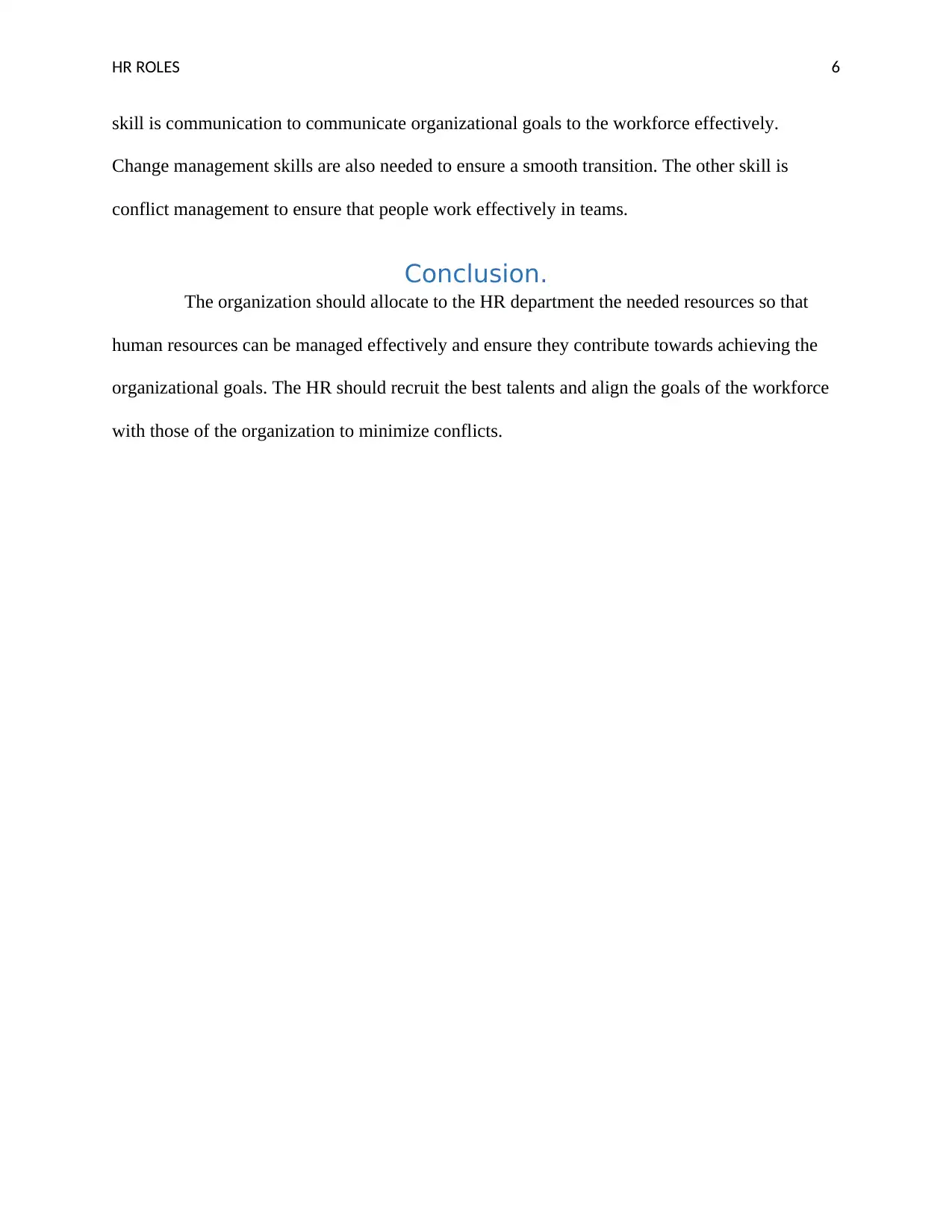
HR ROLES 6
skill is communication to communicate organizational goals to the workforce effectively.
Change management skills are also needed to ensure a smooth transition. The other skill is
conflict management to ensure that people work effectively in teams.
Conclusion.
The organization should allocate to the HR department the needed resources so that
human resources can be managed effectively and ensure they contribute towards achieving the
organizational goals. The HR should recruit the best talents and align the goals of the workforce
with those of the organization to minimize conflicts.
skill is communication to communicate organizational goals to the workforce effectively.
Change management skills are also needed to ensure a smooth transition. The other skill is
conflict management to ensure that people work effectively in teams.
Conclusion.
The organization should allocate to the HR department the needed resources so that
human resources can be managed effectively and ensure they contribute towards achieving the
organizational goals. The HR should recruit the best talents and align the goals of the workforce
with those of the organization to minimize conflicts.
⊘ This is a preview!⊘
Do you want full access?
Subscribe today to unlock all pages.

Trusted by 1+ million students worldwide
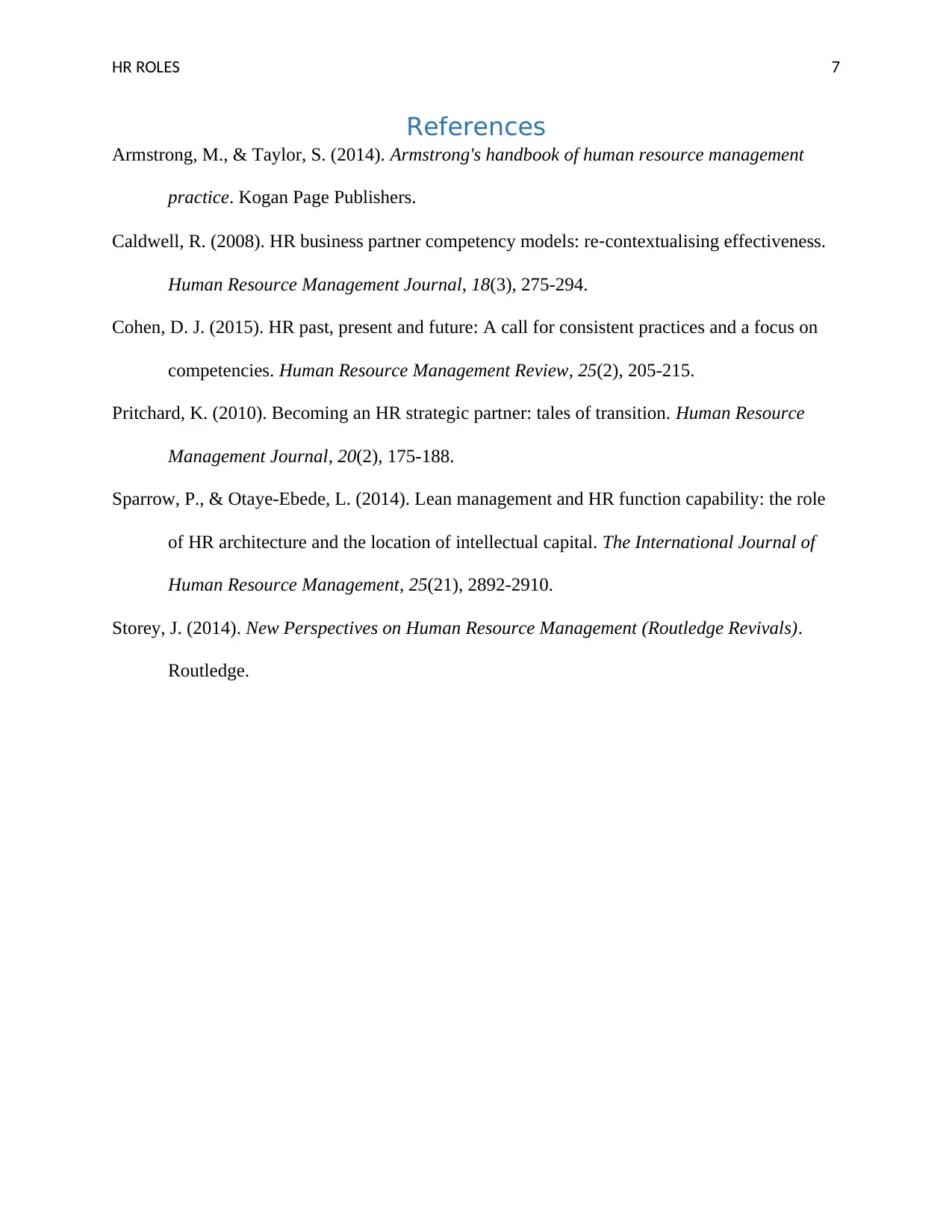
HR ROLES 7
References
Armstrong, M., & Taylor, S. (2014). Armstrong's handbook of human resource management
practice. Kogan Page Publishers.
Caldwell, R. (2008). HR business partner competency models: re‐contextualising effectiveness.
Human Resource Management Journal, 18(3), 275-294.
Cohen, D. J. (2015). HR past, present and future: A call for consistent practices and a focus on
competencies. Human Resource Management Review, 25(2), 205-215.
Pritchard, K. (2010). Becoming an HR strategic partner: tales of transition. Human Resource
Management Journal, 20(2), 175-188.
Sparrow, P., & Otaye-Ebede, L. (2014). Lean management and HR function capability: the role
of HR architecture and the location of intellectual capital. The International Journal of
Human Resource Management, 25(21), 2892-2910.
Storey, J. (2014). New Perspectives on Human Resource Management (Routledge Revivals).
Routledge.
References
Armstrong, M., & Taylor, S. (2014). Armstrong's handbook of human resource management
practice. Kogan Page Publishers.
Caldwell, R. (2008). HR business partner competency models: re‐contextualising effectiveness.
Human Resource Management Journal, 18(3), 275-294.
Cohen, D. J. (2015). HR past, present and future: A call for consistent practices and a focus on
competencies. Human Resource Management Review, 25(2), 205-215.
Pritchard, K. (2010). Becoming an HR strategic partner: tales of transition. Human Resource
Management Journal, 20(2), 175-188.
Sparrow, P., & Otaye-Ebede, L. (2014). Lean management and HR function capability: the role
of HR architecture and the location of intellectual capital. The International Journal of
Human Resource Management, 25(21), 2892-2910.
Storey, J. (2014). New Perspectives on Human Resource Management (Routledge Revivals).
Routledge.
1 out of 7
Related Documents
Your All-in-One AI-Powered Toolkit for Academic Success.
+13062052269
info@desklib.com
Available 24*7 on WhatsApp / Email
![[object Object]](/_next/static/media/star-bottom.7253800d.svg)
Unlock your academic potential
Copyright © 2020–2025 A2Z Services. All Rights Reserved. Developed and managed by ZUCOL.



